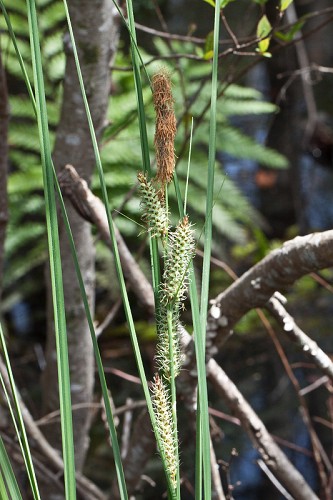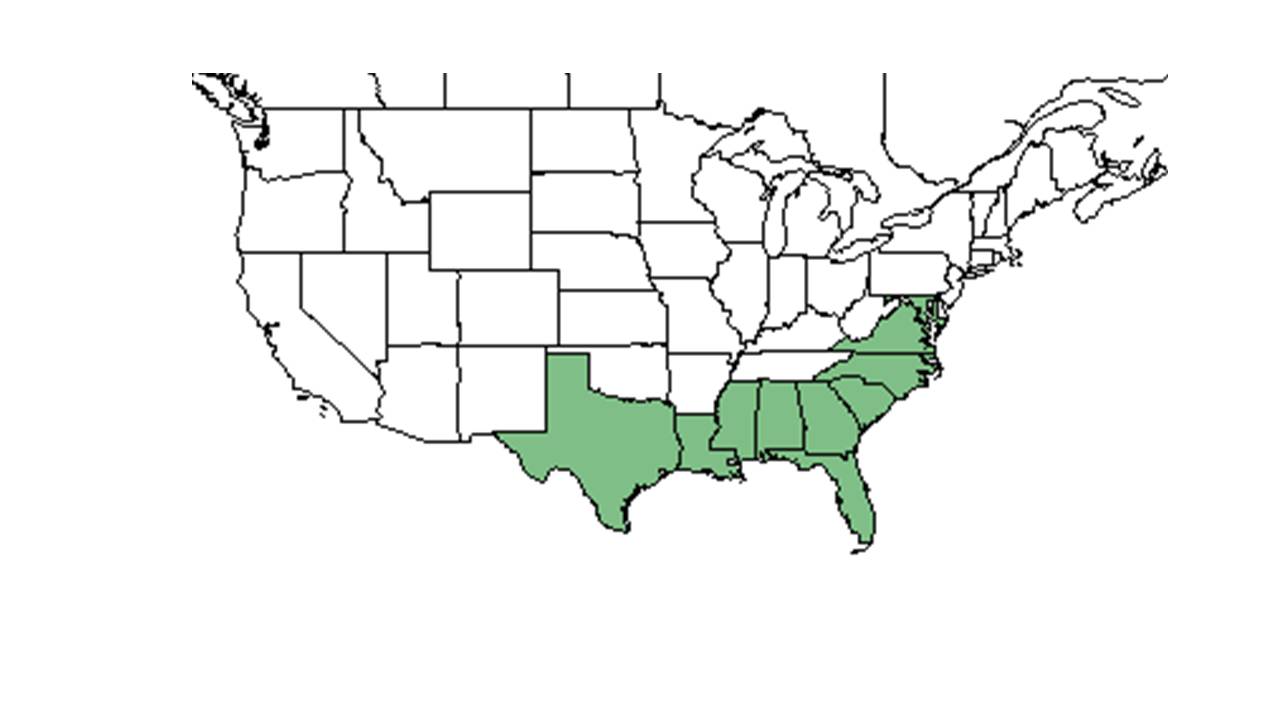Difference between revisions of "Carex verrucosa"
(→Taxonomic notes) |
|||
| (46 intermediate revisions by 13 users not shown) | |||
| Line 3: | Line 3: | ||
{{taxobox | {{taxobox | ||
| name = Carex verrucosa | | name = Carex verrucosa | ||
| − | | image = | + | | image = Care_verr.jpg |
| − | | image_caption = | + | | image_caption = Photo by John R. Gwaltney, [http://www.southeasternflora.com/index.asp Southeastern Flora.com] |
| regnum = Plantae | | regnum = Plantae | ||
| divisio = Magnoliophyta - Flowering plants | | divisio = Magnoliophyta - Flowering plants | ||
| classis = Liliopsida – Monocotyledons | | classis = Liliopsida – Monocotyledons | ||
| − | | ordo = | + | | ordo = Poales |
| familia = Cyperaceae | | familia = Cyperaceae | ||
| genus = ''Carex'' | | genus = ''Carex'' | ||
| Line 15: | Line 15: | ||
| binomial_authority = Muhl. | | binomial_authority = Muhl. | ||
| range_map = CARE_VERR_dist.jpg | | range_map = CARE_VERR_dist.jpg | ||
| − | | range_map_caption = Natural range of ''Carex verrucosa'' from USDA NRCS [http://www.plants.usda.gov Plants Database]. | + | | range_map_caption = Natural range of ''Carex verrucosa'' from USDA NRCS [http://www.plants.usda.gov/core/profile?symbol=CAVE8 Plants Database]. |
}} | }} | ||
| + | Common name: Warty sedge | ||
| + | ==Taxonomic notes== | ||
| + | Synonym: ''Carex glaucescens'' Elliott var. ''androgyna'' M.A. Curtis<ref name=weakley>Weakley, A.S. 2020. Flora of the Southeastern United States. Edition of 20 October 2020. University of North Carolina at Chapel Hill, Chapel Hill, North Carolina.</ref> | ||
| + | |||
| + | Varieties: none<ref name=weakley/> | ||
| + | |||
==Description== | ==Description== | ||
<!-- Basic life history facts such as annual/perrenial, monoecious/dioecious, root morphology, seed type, etc. --> | <!-- Basic life history facts such as annual/perrenial, monoecious/dioecious, root morphology, seed type, etc. --> | ||
| + | A description of ''Carex verrucosa'' is provided in [http://efloras.org/florataxon.aspx?flora_id=1&taxon_id=242357615 The Flora of North America]. | ||
| + | |||
==Distribution== | ==Distribution== | ||
| + | ''Carex verrucosa'' is endemic to the longleaf pine range.<ref>Sorrie, B. A. and A. S. Weakley 2001. Coastal Plain valcular plant endemics: Phytogeographic patterns. Castanea 66: 50-82.</ref>, distributed from southeast North Carolina south to Florida and west to Louisiana.<ref name="natureserve">[[http://explorer.natureserve.org/servlet/NatureServe?searchName=Carex+verrucosa]]NatureServe. Accessed: april 12, 2016</ref> | ||
| + | |||
==Ecology== | ==Ecology== | ||
===Habitat=== <!--Natural communities, human disturbed habitats, topography, hydrology, soils, light, fire regime requirements for removal of competition, etc.--> | ===Habitat=== <!--Natural communities, human disturbed habitats, topography, hydrology, soils, light, fire regime requirements for removal of competition, etc.--> | ||
| − | ===Phenology=== <!--Timing off flowering, fruiting | + | ''Carex verrucosa'' are sedges that are almost restricted to wet savanna communities.<ref name="Walker and Peet 1983">Walker, J. and R. K. Peet (1983). "Composition and species diversity of pine-wiregrass savannas of the Green Swamp, North Carolina." Vegetatio 55: 163-179.</ref> |
| − | ===Seed dispersal=== | + | Thrives in wetland depressions in the southeastern coastal plain.<ref name="Edwards and Weakley et al 2001">Edwards, A. L. and A. S. Weakley (2001). "Population biology and management of rare plants in depression wetlands of the southeastern coastal plain, USA." Natural Areas Journal 21: 12-35.</ref> This species is found in sphagnum bogs in pine woods depressions, cypress ponds, and sweetbay-titi swamps. It is tolerant a range of light levels, from shady to sunny. It grows in sandy loam and peaty soils that are wet to saturated. Also found in roadside ditches.<ref name="fsu">Florida State University Robert K. Godfrey Herbarium database. URL: http://herbarium.bio.fsu.edu. Last accessed: June 2014. Collectors: L. C. Anderson, J. R. Burkhalter, K. C. Burks, G. R. Cooley, S. Cooper, R. J. Eaton, A. Gholson, R. K. Godfrey, D. W. Hall, E. Keppner, L. Keppner, G. R. Knight, R. Kral, S. W. Leonard, D. L. Martin, S. McDaniel, R. A. Norris, A. Schmidt, G. Schultz, C. R. Slaughter, L. B. Trott, and C. E. Wood Jr. States and Counties: Florida: Bay, Calhoun, Clay, Columbia, Duval, Escambia, Franklin, Gadsden, Hamilton, Holmes, Jackson, Jefferson, Leon, Liberty, Marion, Polk, Suwannee, Taylor, Wakulla, Walton, and Washington. Georgia: Thomas.</ref> |
| − | ===Seed bank and germination=== | + | |
| − | ===Fire ecology=== <!--Fire tolerance, fire dependence, adaptive fire responses--> | + | Associated species include ''Carex walteriana, Ilex myrtifolia, Lyonia, Panicum hemitomon, [[Polygala cymosa]], Pontederia, [[Rhynchospora corniculata]], Taxodium distichum'', and others.<ref name="fsu"/> |
| − | ===Pollination=== | + | |
| − | === | + | ===Phenology=== <!--Timing off flowering, fruiting, and environmental triggers. Cite PanFlora website if appropriate: http://www.gilnelson.com/PanFlora/ --> |
| − | ===Diseases and parasites=== | + | The inflorescence is arranged in a spike. It has superior ovaries. ''C. verrucosa'' has been observed flowering from February to July, and also in October and November with peak inflorescence in April and May.<ref>Nelson, G. [http://www.gilnelson.com/ PanFlora]: Plant data for the eastern United States with emphasis on the Southeastern Coastal Plains, Florida, and the Florida Panhandle. www.gilnelson.com/PanFlora/ Accessed: 7 DEC 2016</ref><ref name="fsu"/> The fruit is a nutlet.<ref name="natureserve"/> |
| − | ==Conservation and | + | <!--===Seed dispersal===--> |
| − | == | + | <!--===Seed bank and germination===--> |
| + | |||
| + | ===Fire ecology===<!--Fire tolerance, fire dependence, adaptive fire responses--> | ||
| + | Populations of ''Carex'' species have been known to persist through repeated annual burns.<ref>Robertson, K.M. Unpublished data collected from Pebble Hill Fire Plots, Pebble Hill Plantation, Thomasville, Georgia.</ref> | ||
| + | <!--===Pollination===--> | ||
| + | <!--===Herbivory and toxicology===--> | ||
| + | <!--===Diseases and parasites===--> | ||
| + | |||
| + | ==Conservation, cultivation, and restoration== | ||
| + | |||
| + | ==Cultural use== | ||
| + | ==Photo Gallery== | ||
| + | <gallery widths=180px> | ||
| + | </gallery> | ||
| + | |||
==References and notes== | ==References and notes== | ||
| − | |||
Latest revision as of 18:15, 22 May 2023
| Carex verrucosa | |
|---|---|

| |
| Photo by John R. Gwaltney, Southeastern Flora.com | |
| Scientific classification | |
| Kingdom: | Plantae |
| Division: | Magnoliophyta - Flowering plants |
| Class: | Liliopsida – Monocotyledons |
| Order: | Poales |
| Family: | Cyperaceae |
| Genus: | Carex |
| Species: | C. verrucosa |
| Binomial name | |
| Carex verrucosa Muhl. | |

| |
| Natural range of Carex verrucosa from USDA NRCS Plants Database. | |
Common name: Warty sedge
Contents
Taxonomic notes
Synonym: Carex glaucescens Elliott var. androgyna M.A. Curtis[1]
Varieties: none[1]
Description
A description of Carex verrucosa is provided in The Flora of North America.
Distribution
Carex verrucosa is endemic to the longleaf pine range.[2], distributed from southeast North Carolina south to Florida and west to Louisiana.[3]
Ecology
Habitat
Carex verrucosa are sedges that are almost restricted to wet savanna communities.[4] Thrives in wetland depressions in the southeastern coastal plain.[5] This species is found in sphagnum bogs in pine woods depressions, cypress ponds, and sweetbay-titi swamps. It is tolerant a range of light levels, from shady to sunny. It grows in sandy loam and peaty soils that are wet to saturated. Also found in roadside ditches.[6]
Associated species include Carex walteriana, Ilex myrtifolia, Lyonia, Panicum hemitomon, Polygala cymosa, Pontederia, Rhynchospora corniculata, Taxodium distichum, and others.[6]
Phenology
The inflorescence is arranged in a spike. It has superior ovaries. C. verrucosa has been observed flowering from February to July, and also in October and November with peak inflorescence in April and May.[7][6] The fruit is a nutlet.[3]
Fire ecology
Populations of Carex species have been known to persist through repeated annual burns.[8]
Conservation, cultivation, and restoration
Cultural use
Photo Gallery
References and notes
- ↑ 1.0 1.1 Weakley, A.S. 2020. Flora of the Southeastern United States. Edition of 20 October 2020. University of North Carolina at Chapel Hill, Chapel Hill, North Carolina.
- ↑ Sorrie, B. A. and A. S. Weakley 2001. Coastal Plain valcular plant endemics: Phytogeographic patterns. Castanea 66: 50-82.
- ↑ 3.0 3.1 [[1]]NatureServe. Accessed: april 12, 2016
- ↑ Walker, J. and R. K. Peet (1983). "Composition and species diversity of pine-wiregrass savannas of the Green Swamp, North Carolina." Vegetatio 55: 163-179.
- ↑ Edwards, A. L. and A. S. Weakley (2001). "Population biology and management of rare plants in depression wetlands of the southeastern coastal plain, USA." Natural Areas Journal 21: 12-35.
- ↑ 6.0 6.1 6.2 Florida State University Robert K. Godfrey Herbarium database. URL: http://herbarium.bio.fsu.edu. Last accessed: June 2014. Collectors: L. C. Anderson, J. R. Burkhalter, K. C. Burks, G. R. Cooley, S. Cooper, R. J. Eaton, A. Gholson, R. K. Godfrey, D. W. Hall, E. Keppner, L. Keppner, G. R. Knight, R. Kral, S. W. Leonard, D. L. Martin, S. McDaniel, R. A. Norris, A. Schmidt, G. Schultz, C. R. Slaughter, L. B. Trott, and C. E. Wood Jr. States and Counties: Florida: Bay, Calhoun, Clay, Columbia, Duval, Escambia, Franklin, Gadsden, Hamilton, Holmes, Jackson, Jefferson, Leon, Liberty, Marion, Polk, Suwannee, Taylor, Wakulla, Walton, and Washington. Georgia: Thomas.
- ↑ Nelson, G. PanFlora: Plant data for the eastern United States with emphasis on the Southeastern Coastal Plains, Florida, and the Florida Panhandle. www.gilnelson.com/PanFlora/ Accessed: 7 DEC 2016
- ↑ Robertson, K.M. Unpublished data collected from Pebble Hill Fire Plots, Pebble Hill Plantation, Thomasville, Georgia.